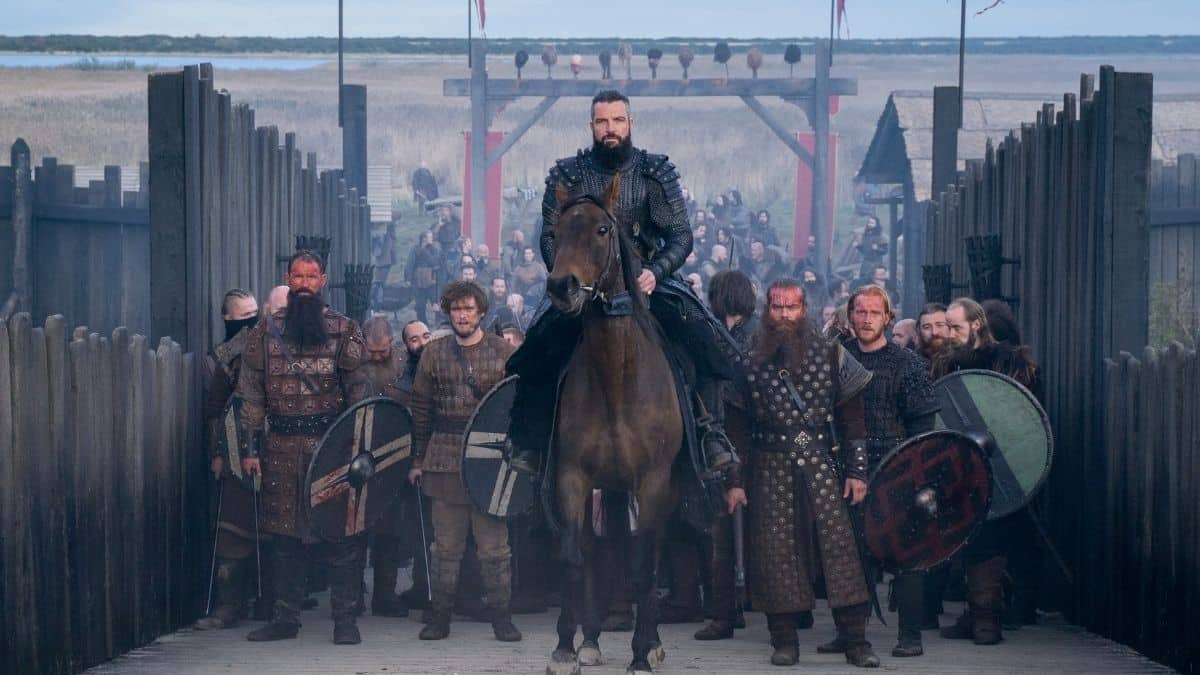
In Season 1 of Vikings: Valhalla, the English fought the Vikings on a bridge in London.
Leif Eriksson (Sam Corlett) had worked out that London Bridge had a flawed design that could be used to their advantage. Work got underway and the Vikings eventually attacked.
King Edmund (Louis Davison) was goaded into his own attack and this led to his downfall as the Vikings had weakened the bridge and caused it to fall. In the process, they managed to capture the prince.
So, did this really happen?
London Bridge is falling down, falling down
According to one interpretation of the traditional English nursery rhyme, London Bridge is Falling Down (also known as London Bridge and My Fair Lady), the Vikings really did make London Bridge collapse.
However, the origin of this is problematic.
A translation of the Heimskringla, published by Samuel Laing in 1844, shows the following verse;
“London Bridge is broken down. —
Gold is won, and bright renown.
Shields resounding,
War-horns sounding,
Hild is shouting in the din!
Arrows singing,
Mail-coats ringing —
Odin makes our Olaf win!”
This makes it look like a battle most certainly happened at London Bridge and that this might be the origin of the nursery rhyme. The only problem with this, though, is that Laing used the nursery rhyme for the basis of his translation of this story within the Heimskringla.
Regardless, in other translations, there is a story told within St. Olav’s saga that could very easily be translated to this same battle that occurred in Vikings: Valhalla.
St. Olav, or King Olav, is also known by the name, Olaf Haraldsson, the character portrayed by Johannes Haukur Johannesson in Vikings: Valhalla, so it is talking about the same group of people.
According to the Dover edition of the Heimskringla (published in 1990 from an earlier 1932 translation by W. Heffer & Sons, Ltd, Cambridge, England), in this attack, King Olav protected his ships with wickerwork and sailed up the river until they were underneath the bridge on the River Thames.
Once here, he attached ropes and sailed away with such force that the bridge collapsed.
During this story, it is King Aethelred that is indecisive over what to do regarding the Vikings. However, in Vikings: Valhalla, Aethelred is already dead at this point and it is his son, unused to warfare and manipulation, that is unsure of what to do until he is goaded into attacking.

The Battle of Stamford
There is another historical event that could also be linked to the battle shown in Vikings: Valhalla.
In an article by IGN, there is the mention of the Battle of Stamford, and this is named as the event that occurred in the TV show.
However, the Battle of Stamford, while occurring on a bridge, is likely not the attack that was used as inspiration for the TV show. The reason being is that Harald Sigurdsson (portrayed by Leo Suter in Vikings: Valhalla) was killed here.
In addition to this, the battle is often referenced as the end of the Viking Age. Occurring on September 25, 1066, it saw a significant loss to the Vikings and, therefore, heralded their downward spiral.
The Battle of Stamford is referenced in the Anglo Saxon Chronicle, a text that recorded all of the major events in England and usually at the time that they occurred, so is believed to hold a decent semblance of accuracy.
On the other hand, the Heimskringla is usually cited as being less accurate since it was written down some 100 years — or more — after the events occurred. However, there is still believed to be some truth to the battle at the bridge recorded within its pages.
Season 1 of Vikings: Valhalla is currently streaming on Netflix.